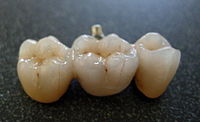
Photo from wikipedia
Abstract Mine tailings account for most of the environmental incidents related to the extractive industry, with risks increasing due to steadily rising tonnage of low-grade ore and extreme weather events.… Click to show full abstract
Abstract Mine tailings account for most of the environmental incidents related to the extractive industry, with risks increasing due to steadily rising tonnage of low-grade ore and extreme weather events. Recycling of tailings in raw-material-intensive applications presents an interesting alternative to costly tailings management with associated restoration efforts. Chemically bonded ceramics may offer a route to upgrading mine tailings into raw materials for ceramics. In this review such chemically bonded ceramic methods that may be used to recycle mine tailings as raw materials, are reviewed while focusing in particular on two methods: 1) geopolymerization/alkali activation and 2) chemically bonded phosphate ceramics. The aim of the review is not to give exhaustive review on the wide topic, but to scope the required boundary conditions that need to be met for such utilization. According to the findings, alkali activation has been studied for 28 separate silicate minerals in the scientific literature, and presents a viable method, which is already in commercial use in calcium-rich cement-like binder applications. Phosphate bonding literature is more focused on phosphate containing minerals and waste encapsulation. Very little work has been done on low-calcium tailings utilization with either technology, and more knowledge is needed on the effect of different pre-treatment methods to increase reactivity of mine tailings in chemically bonded ceramics.
Journal Title: Journal of Cleaner Production
Year Published: 2018
Link to full text (if available)
Share on Social Media: Sign Up to like & get
recommendations!